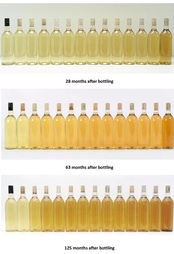A few years ago when the screwcap controversy began to gather steam, a rumor was circulating that one of the premier growth Bordeaux chateau had secretly bottled some of its wine under screwcaps, with a like number sealed with natural cork, then stashed them in the cellar to see how they would age. It’s a nice story that never panned out and was probably just wishful thinking by those folks who were fretting over whether red wines would age under a screwcap.
About 10 years before the rumor took hold, a test was getting underway of 14 bottles of 1999 Clare Valley Semillon sealed with 14 different closures, including multiple natural corks and synthetic closures and one lone screwcap, conducted by the Australian Wine Research Institute (AWRI). The first results were published in 2001 in the Australian Journal of Grape and Wine Research followed by mention in at least 15 other publications. Like many research projects, though, news of the screwcap trial took a while to reach the wine consumer outside Australia.
A recent e-release from Old Bridge Cellars (OBC), a Napa-based importer of Australian wine, brought the startling results of the closure trail into the spotlight for U.S. wine consumers. “A picture is worth a thousand words…but damn it, we’re throwing the words at you too!” was the OBC caption under photos, supplied by AWRI, of a lineup of 14 clear bottles filled with winemaker Kerri Thompson’s Leasingham Estate Semillon. Included is a sequence of photographs showing the aging progression of the Semillon at 28 months, 63 months and 125 months, with an Auscap screwcap closure with a saran tin lined, on the left. At 28 months, the wine in all of the bottles except the one on the far right, closed with a synthetic Betacorque stopper, still looked healthy and with little oxidation. But AWRI Group Manager Peter Godden had this reaction: “Most of the wines sealed with closures other than (the) screwcap were completely undrinkable, some synthetic corks (sic) didn’t even last 28 months.” Natural cork manufacturers are touchy about other non-cork closures being referred to as cork.
clear bottles filled with winemaker Kerri Thompson’s Leasingham Estate Semillon. Included is a sequence of photographs showing the aging progression of the Semillon at 28 months, 63 months and 125 months, with an Auscap screwcap closure with a saran tin lined, on the left. At 28 months, the wine in all of the bottles except the one on the far right, closed with a synthetic Betacorque stopper, still looked healthy and with little oxidation. But AWRI Group Manager Peter Godden had this reaction: “Most of the wines sealed with closures other than (the) screwcap were completely undrinkable, some synthetic corks (sic) didn’t even last 28 months.” Natural cork manufacturers are touchy about other non-cork closures being referred to as cork.
The evidence is clear in the “28 months after bottling” photo showing the far right bottle as more brown in color than any of the others and the browning of oxidation only gets worse at 63 and 125 months. It’s a sobering disclosure, especially for all of us consumers with white wines more than two years old in our collection. “The biggest issue for any form of cork closure is variability,” says Godden. “The wines sealed with screwcap were extremely consistent bottle to bottle and no other closure achieved results even similar.” He added that the considerable variation in the results for synthetic closures and natural cork closures was of greater concern than issues with TCA cork.
More important, Godden points out that the systematic sensory analysis conducted over the 10 year period revealed that the wines sealed under screwcap were still drinkable and showing appealing secondary aged characters while retaining freshness. It is this revelation that prompted the folks at Old Bridge Cellars to ask, “Could you be missing the point on screwcaps?” Maybe so, and after looking closely at the “63 months after bottling” photo I am a believer in the benefits of screwcaps more now More convincing is “125 months after bottling” photo that clearly shows all but the two wines on the left of the photo are oxidized.
The results of this screwcap trial conducted by AWRI brings up a number of questions such as the reductive character (a chemical reaction associated with oxidation) in the wine which some critics claim is a major fault of screwcaps. And, although Australians have been conducting both red and white wine screwcap trials for more than 20 years, some doubters still wonder about aging red wine under screwcap. But these AWRI trial photos are worth more than a thousand words, especially if you like your white wine fresh and lively and offering the grape characteristics intended by the winemaker.
6
